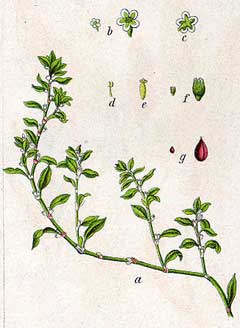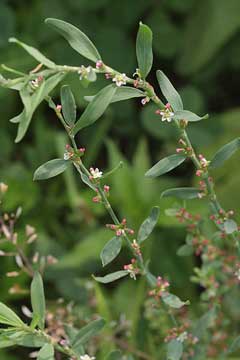 |
|
http://commons.wikimedia.org/wiki/File:Polygonum_aviculare_Sturm63.jpg |
 |
| http://commons.wikimedia.org/wiki/User:Dalgial |
Translate this page:
Summary
Physical Characteristics

 Polygonum_aviculare is a ANNUAL growing to 0.3 m (1ft).
Polygonum_aviculare is a ANNUAL growing to 0.3 m (1ft).
See above for USDA hardiness. It is hardy to UK zone 5. It is in flower from June to October, and the seeds ripen from August to October. The species is hermaphrodite (has both male and female organs) and is pollinated by Insects. The plant is self-fertile.
It is noted for attracting wildlife.
Suitable for: light (sandy), medium (loamy) and heavy (clay) soils. Suitable pH: mildly acid, neutral and basic (mildly alkaline) soils and can grow in very acid soils.
It can grow in semi-shade (light woodland) or no shade. It prefers moist soil. The plant can tolerate maritime exposure.
UK Hardiness Map
US Hardiness Map
Synonyms
P. heterophyllum. P. littorale.
Plant Habitats
Edible Uses
Young leaves and plants - raw or cooked[105, 177]. Used as a potherb[183], they are very rich in zinc[179]. A nutritional analysis is available[218]. Seed - raw or cooked. Rather small and fiddly to utilize, they can be used in all the ways that buckwheat (Fagopyrum esculentum) is used, either whole or dried and ground into a powder for use in pancakes, biscuits and piñole[4, 55, 106, 161, 183]. The leaves are a tea substitute[183].
References More on Edible Uses
| Composition
|
| Figures in grams (g) or miligrams (mg) per 100g of food.
|
|
|
Leaves (Fresh weight)
|
|
- 0 Calories per 100g
- Water : 81.6%
- Protein: 1.9g; Fat: 0.3g; Carbohydrate: 10.2g; Fibre: 3.5g; Ash: 3.5g;
- Minerals - Calcium: 0mg; Phosphorus: 0mg; Iron: 0mg; Magnesium: 0mg; Sodium: 0mg; Potassium: 0mg; Zinc: 0mg;
- Vitamins - A: 0mg; Thiamine (B1): 0mg; Riboflavin (B2): 0mg; Niacin: 0mg; B6: 0mg; C: 0mg;
- Reference: [ 218]
- Notes:
|
|
Medicinal Uses
Plants For A Future can not take any responsibility for any adverse effects from the use of plants. Always seek advice from a professional before using a plant medicinally.
Knotweed is a safe and effective astringent and diuretic herb that is used mainly in the treatment of complaints such as dysentery and haemorrhoids. It is also taken in the treatment of pulmonary complaints because the silicic acid it contains strengthens connective tissue in the lungs[254]. The whole plant is anthelmintic, astringent, cardiotonic, cholagogue, diuretic, febrifuge, haemostatic, lithontripic and vulnerary[4, 7, 9, 21, 53, 147, 172, 176, 178]. It was formerly widely used as an astringent both internally and externally in the treatment of wounds, bleeding, piles and diarrhoea[4]. Its diuretic properties make it useful in removing stones[4]. An alcohol-based preparation has been used with success to treat varicose veins of recent origin[7]. The plant is harvested in the summer and early autumn and is dried for later use[9]. The leaves are anthelmintic, diuretic and emollient[218]. The whole plant is anthelmintic, antiphlogistic and diuretic[218]. The juice of the plant is weakly diuretic, expectorant and vasoconstrictor[218]. Applied externally, it is an excellent remedy to stay bleeding of the nose and to treat sores[4]. The seeds are emetic and purgative[4, 240]. Recent research has shown that the plant is a useful medicine for bacterial dysentery. Of 108 people with this disease, 104 recovered within 5 days when treated internally with a paste of knotweed[254].
References More on Medicinal Uses
The Bookshop: Edible Plant Books
Our Latest books on Perennial Plants For Food Forests and Permaculture Gardens in paperback or digital formats.

Edible Tropical Plants
Food Forest Plants for Hotter Conditions: 250+ Plants For Tropical Food Forests & Permaculture Gardens.
More

Edible Temperate Plants
Plants for Your Food Forest: 500 Plants for Temperate Food Forests & Permaculture Gardens.
More

More Books
PFAF have eight books available in paperback and digital formats. Browse the shop for more information.
Shop Now
Other Uses
Yields a blue dye that is not much inferior to indigo[115]. The part used is not specified, but it is likely to be the leaves. Yellow and green dyes are obtained from the whole plant[168]. The roots contain tannins, but the quantity was not given[223].
Special Uses
References More on Other Uses
Cultivation details
Succeeds in an ordinary garden soil[1] but prefers a moisture retentive not too fertile soil in sun or part shade[200]. Repays generous treatment, in good soils the plant will cover an area up to a metre in diameter[1, 4]. Prefers an acid soil[20]. Dislikes shade. Knotweed is a common and invasive weed of cultivated ground[7]. It is an important food plant for the caterpillars of many species of butterflies[30]. It also produces an abundance of seeds and these are a favourite food for many species of birds[4]. Plants seem to be immune to the predations of rabbits[233]. The flowers have little or no scent or honey and are rarely visited by pollinating insects. Self-fertilization is the usual method of reproduction, though cross-fertilization by insects does sometimes occur[4]. The plant also produces cleistogomous flowers - these never open and therefore are always self-fertilized[4]. The plant is very variable and is seen by most botanists as an aggregate species of 4 very variable species, viz. - P. aviculare. L.; P. boreale. (Lange.)Small.; P. rurivacum. Jord. ex Box.; and P. arenastrum. Box[17].
References Carbon Farming Information and Carbon Sequestration Information
Temperature Converter
Type a value in the Celsius field to convert the value to Fahrenheit:
Fahrenheit:
The PFAF Bookshop
Plants For A Future have a number of books available in paperback and digital form. Book titles include Edible Plants, Edible Perennials, Edible Trees,Edible Shrubs, Woodland Gardening, and Temperate Food Forest Plants. Our new book is Food Forest Plants For Hotter Conditions (Tropical and Sub-Tropical).
Shop Now
Plant Propagation
Seed - sow spring in a cold frame. Germination is usually free and easy. When they are large enough to handle, prick the seedlings out into individual pots and plant them out in the summer if they have reached sufficient size. If not, overwinter them in a cold frame and plant them out the following spring after the last expected frosts. Division in spring or autumn. Very easy, larger divisions can be planted out direct into their permanent positions. We have found that it is better to pot up the smaller divisions and grow them on in light shade in a cold frame until they are well established before planting them out in late spring or early summer.
Other Names
If available other names are mentioned here
Native Range
Coming Soon
Weed Potential
Right plant wrong place. We are currently updating this section.
Please note that a plant may be invasive in one area but may not in your area so it's worth checking.
Conservation Status
IUCN Red List of Threatened Plants Status :

Growth: S = slow M = medium F = fast. Soil: L = light (sandy) M = medium H = heavy (clay). pH: A = acid N = neutral B = basic (alkaline). Shade: F = full shade S = semi-shade N = no shade. Moisture: D = dry M = Moist We = wet Wa = water.
Now available:
Food Forest Plants for Mediterranean Conditions
350+ Perennial Plants For Mediterranean and Drier Food Forests and Permaculture Gardens.
[Paperback and eBook]
This is the third in Plants For A Future's series of plant guides for food forests tailored to
specific climate zones. Following volumes on temperate and tropical ecosystems, this book focuses
on species suited to Mediterranean conditions—regions with hot, dry summers and cool, wet winters,
often facing the added challenge of climate change.
Read More
Expert comment
Author
L.
Botanical References
17
Links / References
For a list of references used on this page please go here
Readers comment